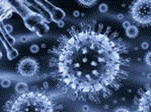Virology and viruses
A major branch of virology is virus classification. Viruses can be classified according to the host cell they infect: animal viruses, plant viruses, fungal viruses, and bacteriophages (viruses infecting bacteria, which include the most complex viruses). Another classification uses the geometrical shape of their capsid (often a helix or an icosahedron) or the virus's structure (e.g. presence or absence of a lipidenvelope). Viruses range in size from about 30 nm to about 450nm, which means that most of them cannot be seen with light microscopes. The shape and structure of viruses has been studied by electron microscopy, NMR spectroscopy, and X-ray crystallography. A virus is a small infectious agent that can replicate only inside the living cells of organisms. Viruses infect all types of organisms, from animals and plants to bacteria. Since the initial discovery of the tobacco mosaic virus in 1898, about 5,000 viruses have been described in detail, although there are millions of different types. Viruses are found in almost every ecosystem on Earth. Virus particles (known as virions) consist of two or three parts: the genetic material made from either DNA or RNA, long molecules that carry genetic information; a protein coat that protects these genes; and in some cases an envelope of lipids that surrounds the protein coat when they are outside a cell. The average virus is about one one-hundredth the size of the average bacterium. Viruses cause a number of diseases in eukaryotes. In humans, smallpox, the common cold, influenza, diseases. Viral infections in animals provoke an immune response that usually eliminates the infecting virus. Vaccines can also produce immune responses. However, some viruses including those causing AIDS and viral hepatitis evade these immune responses and result in chronic infections. Antibiotics have no effect on viruses, but several antiviral drugs have been developed. The origins of viruses in the evolutionary history of life are unclear: some may have evolved from plasmids – pieces of DNA that can move between cells – while others may have evolved from bacteria. The evolution of viruses, which often occurs in concert with the evolution of their hosts, is studied in the field of viral evolution. While viruses reproduce and evolve, they don't engage in metabolism and depend on a host cell for reproduction. The often-debated question of whether they are alive or not is a matter of definition that does not affect the biological reality of viruses.
|

 Virology is the study of viruses and virus-like agents: their structure, classification and evolution, their ways to infect and exploit cells for virus reproduction, the diseases they cause, the techniques to isolate and culture them, and their use in research and therapy. Virology is often considered as a part of microbiology.
Virology is the study of viruses and virus-like agents: their structure, classification and evolution, their ways to infect and exploit cells for virus reproduction, the diseases they cause, the techniques to isolate and culture them, and their use in research and therapy. Virology is often considered as a part of microbiology.


